
Program Guide (123)
Children categories
Comments in Excel are blocks of text that can be added to cells, mainly used to provide additional explanation or supplemental information about the cell contents. Users can add comments to the specific cells to better explain the data of worksheets. However, sometimes too many comments will cause visual clutter or obstruct other content. To avoid this issue, existing comments can be hidden programmatically to make the worksheet more organized and readable. Hidden comments can also be easily displayed when necessary. This article will show you how to hide or show comments in Excel using Spire.XLS for Java.
Install Spire.XLS for Java
First of all, you're required to add the Spire.Xls.jar file as a dependency in your Java program. The JAR file can be downloaded from this link. If you use Maven, you can easily import the JAR file in your application by adding the following code to your project's pom.xml file.
<repositories>
<repository>
<id>com.e-iceblue</id>
<name>e-iceblue</name>
<url>https://repo.e-iceblue.com/nexus/content/groups/public/</url>
</repository>
</repositories>
<dependencies>
<dependency>
<groupId>e-iceblue</groupId>
<artifactId>spire.xls</artifactId>
<version>14.4.1</version>
</dependency>
</dependencies>
Hide Comments in Excel
Spire.XLS for Java provides the Worksheet.getComments().get().isVisble() method to control the visibility of comments. You can easily hide existing comments by setting the parameter of this method to "false". The following are detailed steps to hide comments in excel.
- Create an object of Workbook class.
- Load a sample file from disk using Workbook.loadFromFile() method.
- Get the desired worksheet of this file by calling Workbook.getWorksheets().get() method.
- Hide the specific comments in this sheet by setting the parameter of the Worksheet.getComments().get().isVisble() method to "false".
- Finally, save the result file using Workbook.savaToFile() method.
- Java
import com.spire.xls.ExcelVersion;
import com.spire.xls.Workbook;
import com.spire.xls.Worksheet;
public class HideComment {
public static void main(String[] args){
//Create an object of Workbook class
Workbook workbook = new Workbook();
//Load a sample file from disk
workbook.loadFromFile("Sample.xlsx");
//Get the first worksheet in this file
Worksheet sheet = workbook.getWorksheets().get(0);
//Hide the first and the second comments in this sheet
sheet.getComments().get(0).isVisible(false);
sheet.getComments().get(1).isVisible(false);
//Save the result file
workbook.saveToFile("HideComment.xlsx", ExcelVersion.Version2013);
workbook.dispose();
}
}

Show Comments in Excel
Hidden comments can also be easily displayed when necessary. If you want to show them again, please set the parameter of the Worksheet.getComments().get().isVisble() method to "true". The following are detailed steps of showing hidden comments in excel.
- Create an object of Workbook class.
- Load a sample file from disk using Workbook.loadFromFile() method.
- Get the desired worksheet by calling Workbook.getWorksheets().get() method.
- Show the specific comment in this sheet by setting the parameter of the Worksheet.getComments().get().isVisble() method to "true".
- Finally, save the result file using Workbook.savaToFile() method.
- Java
import com.spire.xls.ExcelVersion;
import com.spire.xls.Workbook;
import com.spire.xls.Worksheet;
public class ShowComment {
public static void main(String[] args){
//Create an object of Workbook class
Workbook workbook = new Workbook();
//Load a sample file from disk
workbook.loadFromFile("HideComment.xlsx");
//Get the first worksheet in this file
Worksheet sheet = workbook.getWorksheets().get(0);
//Show the first comment in this sheet
sheet.getComments().get(0).isVisible(true);
//Save the result file
workbook.saveToFile("ShowComment.xlsx", ExcelVersion.Version2013);
workbook.dispose();
}
}

Apply for a Temporary License
If you'd like to remove the evaluation message from the generated documents, or to get rid of the function limitations, please request a 30-day trial license for yourself.
Gridlines are horizontal and vertical faint lines that differentiate between cells in a worksheet. All Excel worksheets have gridlines by default, but sometimes you may need to remove the gridlines as they might interfere with your work. In this article, you will learn how to programmatically show or hide/remove gridlines in an Excel worksheet using Spire.XLS for Java.
Install Spire.XLS for Java
First, you're required to add the Spire.Xls.jar file as a dependency in your Java program. The JAR file can be downloaded from this link. If you use Maven, you can easily import the JAR file in your application by adding the following code to your project's pom.xml file.
<repositories>
<repository>
<id>com.e-iceblue</id>
<name>e-iceblue</name>
<url>https://repo.e-iceblue.com/nexus/content/groups/public/</url>
</repository>
</repositories>
<dependencies>
<dependency>
<groupId>e-iceblue</groupId>
<artifactId>spire.xls</artifactId>
<version>14.4.1</version>
</dependency>
</dependencies>
Hide or Show Gridlines in Excel
The detailed steps are as follows.
- Create a Workbook object.
- Load a sample Excel document using Workbook.loadFromFile() method.
- Get a specified worksheet using Workbook.getWorksheets().get() method.
- Hide or show gridlines in the specified worksheet using Worksheet.setGridLinesVisible() method.
- Save the result file using Workbook.saveToFile() method.
- Java
import com.spire.xls.ExcelVersion;
import com.spire.xls.Workbook;
import com.spire.xls.Worksheet;
public class HideOrShowGridlines {
public static void main(String[] args) {
//Create a Workbook object
Workbook workbook = new Workbook();
//Load a sample Excel document
workbook.loadFromFile("E:\\Files\\Test.xlsx");
//Get the first worksheet
Worksheet worksheet = workbook.getWorksheets().get(0);
//Hide gridlines
worksheet.setGridLinesVisible(false);
////Show gridlines
//worksheet.setGridLinesVisible(true);
//Save the document
workbook.saveToFile("HideGridlines.xlsx", ExcelVersion.Version2016);
}
}
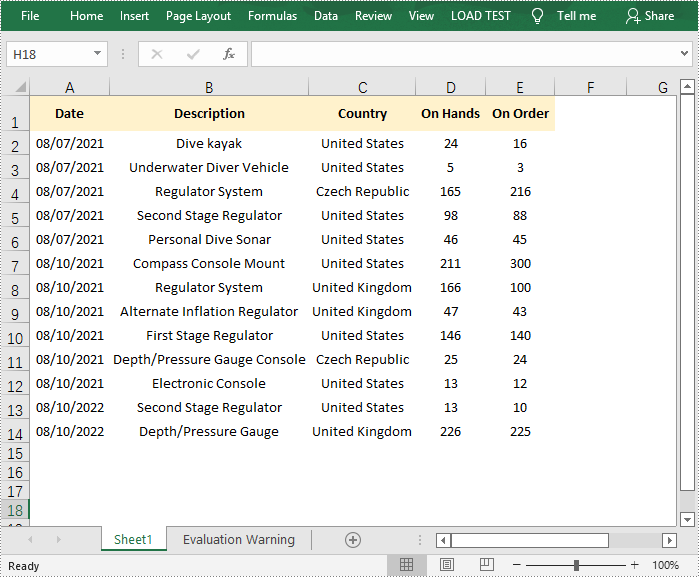
Apply for a Temporary License
If you'd like to remove the evaluation message from the generated documents, or to get rid of the function limitations, please request a 30-day trial license for yourself.
Set Different Header and Footer for the First Page in Java
2020-04-27 07:47:25 Written by support iceblueThis article demonstrates how to set different header and footer for the fisrt page using Spire.XLS for Java.
import com.spire.xls.FileFormat;
import com.spire.xls.Workbook;
import com.spire.xls.Worksheet;
public class SetDifferentHeaderFooter {
public static void main(String[] args) {
//Create a Workbook instance
Workbook workbook = new Workbook();
//Get the first worksheet
Worksheet sheet = workbook.getWorksheets().get(0);
//Insert text in A1 and J1
sheet.getCellRange("A1").setText("page 1");
sheet.getCellRange("J1").setText("page 2");
//Set different first page
sheet.getPageSetup().setDifferentFirst((byte)1);
//Set header string and footer string for the first page
sheet.getPageSetup().setFirstHeaderString("First header");
sheet.getPageSetup().setFirstFooterString("First footer");
//Set header string and footer string for other pages
sheet.getPageSetup().setCenterHeader("Header of other pages");
sheet.getPageSetup().setCenterFooter("Footer of other pages");
//Save the document
workbook.saveToFile("DifferentFirstPage.xlsx", FileFormat.Version2016);
}
}

This article will demonstrate how to add the traffic lights icons in Java applications by using Spire.XLS for Java.
import com.spire.xls.*;
import com.spire.xls.core.IConditionalFormat;
import com.spire.xls.core.spreadsheet.collections.XlsConditionalFormats;
import java.awt.*;
public class setTrafficLightsIcons {
public static void main(String[] args) {
//Create a workbook
Workbook workbook = new Workbook();
//Add a worksheet
Worksheet sheet = workbook.getWorksheets().get(0);
//Add some data to the cell range and set the format for them
sheet.getCellRange("A1").setText("Traffic Lights");
sheet.getCellRange("A2").setNumberValue(0.95);
sheet.getCellRange("A2").setNumberFormat("0%");
sheet.getCellRange("A3").setNumberValue(0.5);
sheet.getCellRange("A3").setNumberFormat("0%");
sheet.getCellRange("A4").setNumberValue(0.1);
sheet.getCellRange("A4").setNumberFormat("0%");
sheet.getCellRange("A5").setNumberValue(0.9);
sheet.getCellRange("A5").setNumberFormat("0%");
sheet.getCellRange("A6").setNumberValue(0.7);
sheet.getCellRange("A6").setNumberFormat("0%");
sheet.getCellRange("A7").setNumberValue(0.6);
sheet.getCellRange("A7").setNumberFormat("0%");
//Set the height of row and width of column for Excel cell range
sheet.getAllocatedRange().setRowHeight(20);
sheet.getAllocatedRange().setColumnWidth(25);
//Add a conditional formatting
XlsConditionalFormats conditional = sheet.getConditionalFormats().add();
conditional.addRange(sheet.getAllocatedRange());
IConditionalFormat format1 = conditional.addCondition();
//Add a conditional formatting of cell range and set its type to CellValue
format1.setFormatType(ConditionalFormatType.CellValue);
format1.setFirstFormula("300");
format1.setOperator(ComparisonOperatorType.Less);
format1.setFontColor(Color.black);
format1.setBackColor(Color.lightGray);
//Add a conditional formatting of cell range and set its type to IconSet
conditional.addRange(sheet.getAllocatedRange());
IConditionalFormat format = conditional.addCondition();
format.setFormatType(ConditionalFormatType.IconSet);
format.getIconSet().setIconSetType(IconSetType.ThreeTrafficLights1);
//Save to file
String result = "output/setTrafficLightsIcons_result.xlsx";
workbook.saveToFile(result, ExcelVersion.Version2013);
}
}
Effective screenshot of traffic lights icons on Excel worksheet:
![]()
This article will introduce how to add a picture to Excel chart in java applications by using Spire.XLS for java.
import com.spire.xls.*;
import com.spire.xls.core.IPictureShape;
import com.spire.xls.core.IShape;
import java.awt.*;
public class addPictureToChart {
public static void main(String[] args) {
//Load the document from disk
Workbook workbook = new Workbook();
workbook.loadFromFile("Sample.xlsx");
//get the first worksheet
Worksheet sheet = workbook.getWorksheets().get(0);
//get the first chart
Chart chart = sheet.getCharts().get(0);
//add the picture to chart and set its format
IShape picture = chart.getShapes().addPicture("48.png");
((IPictureShape) picture).getLine().setDashStyle(ShapeDashLineStyleType.DashDotDot);
((IPictureShape) picture).getLine().setForeColor(Color.blue);
//save the document
String result = "output/AddPictureToChart.xlsx";
workbook.saveToFile(result, ExcelVersion.Version2010);
}
}
Effective screenshot after adding picture to Excel Chart:
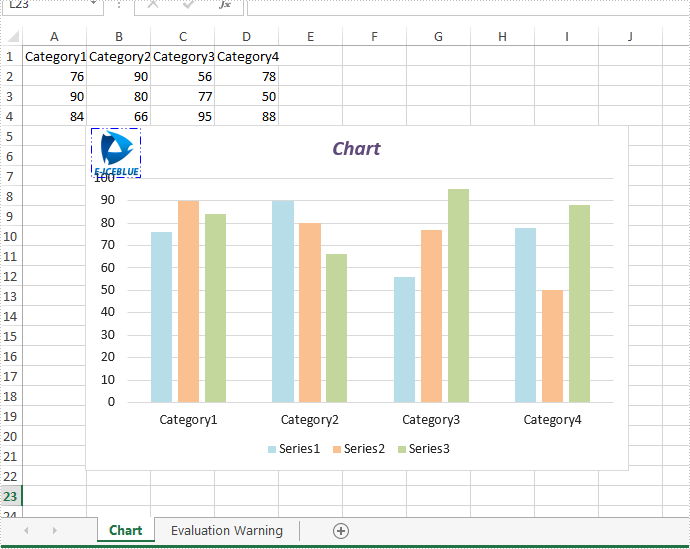
Java: Highlight Values Above or Below Average in Excel
2022-09-30 09:04:00 Written by support iceblueIf you have a lot of data in Excel, finding the special values can be challenging. In this situation, you can use the conditional formatting to automatically highlight the cells that contain the value that meets certain criteria. This article introduces how to highlight values that are above or below the average using conditional formatting in Java, using Spire.XLS for Java.
Install Spire.XLS for Java
First, you're required to add the Spire.Xls.jar file as a dependency in your Java program. The JAR file can be downloaded from this link. If you use Maven, you can easily import the JAR file in your application by adding the following code to your project's pom.xml file.
<repositories>
<repository>
<id>com.e-iceblue</id>
<name>e-iceblue</name>
<url>https://repo.e-iceblue.com/nexus/content/groups/public/</url>
</repository>
</repositories>
<dependencies>
<dependency>
<groupId>e-iceblue</groupId>
<artifactId>spire.xls</artifactId>
<version>14.4.1</version>
</dependency>
</dependencies>
Highlight Values Above or Below Average Excel in Java
Below are the steps to highlight values above or below average in Excel using Spire.XLS for Java.
- Create a Workbook object.
- Load an Excel file using Workbook.loadFromFile() method.
- Get a specific worksheet from the workbook using Workbook.getWorksheets.get(index) method.
- Add a conditional formatting to the worksheet using Worksheet.getConditionalFormats().add() method and return an object of XlsConditionalFormats class.
- Set the cell range where the conditional formatting will be applied using XlsConditionalFormats.AddRange() method.
- Add an average condition using XlsConditionalFormats.addAverageCondition() method, specify the average type to above and change the background color of the cells that meet the condition to yellow.
- Add another average condition to change the background color of the cells that contain the value below average to light gray.
- Save the workbook to an Excel file using Workbook.saveToFile() method.
- Java
import com.spire.xls.AverageType;
import com.spire.xls.ExcelVersion;
import com.spire.xls.Workbook;
import com.spire.xls.Worksheet;
import com.spire.xls.core.IConditionalFormat;
import com.spire.xls.core.spreadsheet.collections.XlsConditionalFormats;
import java.awt.*;
public class HighlightValuesAboveAndBelowAverage {
public static void main(String[] args) {
//Create a Workbook object
Workbook workbook = new Workbook();
//Load an Excel file
workbook.loadFromFile("C:\\Users\\Administrator\\Desktop\\sample.xlsx");
//Get the first worksheet
Worksheet sheet = workbook.getWorksheets().get(0);
//Add a conditional format to the worksheet
XlsConditionalFormats format = sheet.getConditionalFormats().add();
//Set the range where the conditional format will be applied
format.addRange(sheet.getRange().get("F2:F14"));
//Add a condition to highlight values above average with yellow
IConditionalFormat condition1 = format.addAverageCondition(AverageType.Above);
condition1.setBackColor(Color.yellow);
//Add a condition to highlight values below average with light gray
IConditionalFormat condition2 = format.addAverageCondition(AverageType.Below);
condition2.setBackColor(Color.lightGray);
//Get the count of values below average
sheet.getRange().get("F17").setFormula("=COUNTIF(F2:F14,\"<\"&AVERAGE(F2:F14))");
//Get the count of values above average
sheet.getRange().get("F18").setFormula("=COUNTIF(F2:F14,\">\"&AVERAGE(F2:F14))");
//Save the workbook to an Excel file
workbook.saveToFile("output/HighlightValues.xlsx", ExcelVersion.Version2016);
}
}
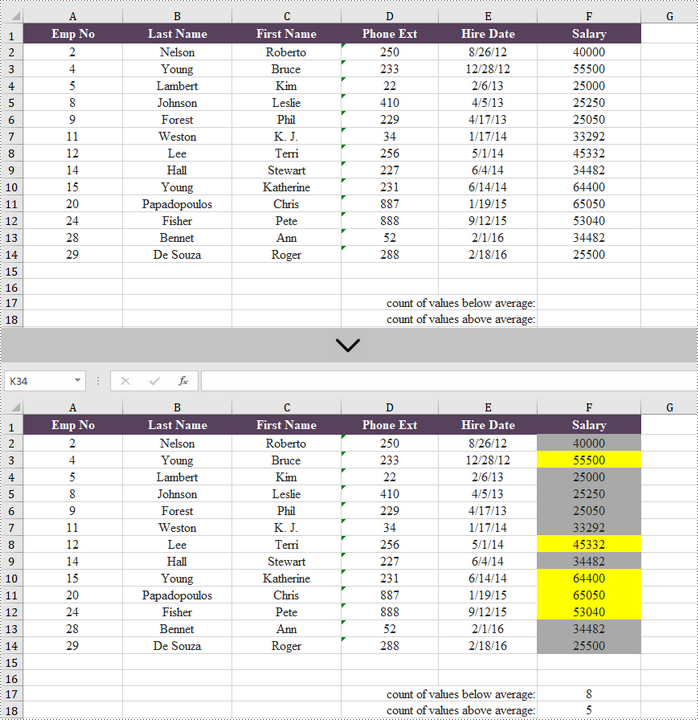
Apply for a Temporary License
If you'd like to remove the evaluation message from the generated documents, or to get rid of the function limitations, please request a 30-day trial license for yourself.
This article demonstrates how to highlight the highest and lowest value in a cell rang through conditional formatting. You can also highlight the top 5 or bottom 5 values by passing 5 to setRank() method in the code snippet below.
import com.spire.xls.*;
import java.awt.*;
public class HighlightTopBottom {
public static void main(String[] args) {
//Create a Workbook object
Workbook workbook = new Workbook();
//Load the sample Excel file
workbook.loadFromFile("G:\\360MoveData\\Users\\Administrator\\Desktop\\sales report.xlsx");
//Get the first worksheet
Worksheet sheet = workbook.getWorksheets().get(0);
//Apply conditional formatting to range "B2:E5" to highlight the highest value
ConditionalFormatWrapper format1 = sheet.getCellRange("B2:E5").getConditionalFormats().addCondition();
format1.setFormatType(ConditionalFormatType.TopBottom);
format1.getTopBottom().setType(TopBottomType.Top);
format1.getTopBottom().setRank(1);
format1.setBackColor(Color.red);
//Apply conditional formatting to range "B2:E5" to highlight the lowest value
ConditionalFormatWrapper format2 = sheet.getCellRange("B2:E5").getConditionalFormats().addCondition();
format2.setFormatType(ConditionalFormatType.TopBottom);
format2.getTopBottom().setType(TopBottomType.Bottom);
format2.getTopBottom().setRank(1);
format2.setBackColor(Color.yellow);
//Save the document
workbook.saveToFile("output/HighestLowestValue.xlsx", ExcelVersion.Version2016);
}
}
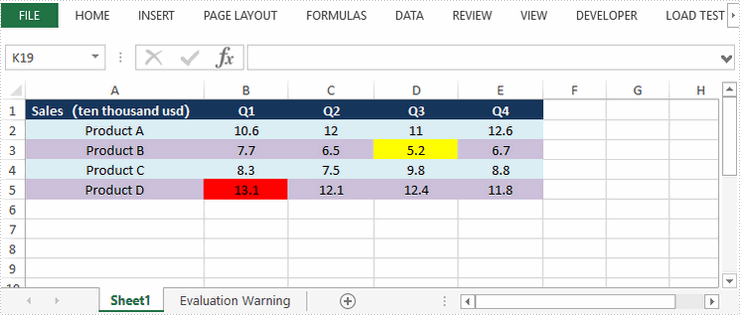
Highlight Dulicate and Unique Values in Excel in Java
2020-04-08 02:00:56 Written by support iceblueThis article demonstrates how to highlight the duplicate and unique values in a selected range through conditional formatting using Spire.XLS for Java.
import com.spire.xls.*;
import java.awt.*;
public class HighlightDuplicates {
public static void main(String[] args) {
//Create a Workbook instance
Workbook workbook = new Workbook();
//Load a sample Excel file
workbook.loadFromFile("C:\\Users\\Administrator\\Desktop\\sample.xlsx");
//Get the first worksheet
Worksheet sheet = workbook.getWorksheets().get(0);
//Use conditional formatting to highlight duplicate values in the range "A2:A11" with red
ConditionalFormatWrapper format1 = sheet.getCellRange("A2:A11").getConditionalFormats().addCondition();
format1.setFormatType(ConditionalFormatType.DuplicateValues);
format1.setBackColor(Color.red);
//Use conditional formatting to highlight unique values in the range "A2:A11" with yellow
ConditionalFormatWrapper format2 = sheet.getCellRange("A2:A11").getConditionalFormats().addCondition();
format2.setFormatType(ConditionalFormatType.UniqueValues);
format2.setBackColor(Color.yellow);
//Save the document
workbook.saveToFile("HighlightDuplicates.xlsx", ExcelVersion.Version2016);
}
}

Pivot table is a powerful tool in Excel that supports categorizing, sorting, filtering, and summarizing data. It is often used in situations where data needs to be aggregated and analyzed for reporting. This article will demonstrate how to programmatically create a pivot table in Excel using Spire.XLS for Java.
Install Spire.XLS for Java
First, you're required to add the Spire.Xls.jar file as a dependency in your Java program. The JAR file can be downloaded from this link. If you use Maven, you can easily import the JAR file in your application by adding the following code to your project's pom.xml file.
<repositories>
<repository>
<id>com.e-iceblue</id>
<name>e-iceblue</name>
<url>https://repo.e-iceblue.com/nexus/content/groups/public/</url>
</repository>
</repositories>
<dependencies>
<dependency>
<groupId>e-iceblue</groupId>
<artifactId>spire.xls</artifactId>
<version>14.4.1</version>
</dependency>
</dependencies>
Create a Pivot Table in Excel
The detailed steps are as follows.
- Create a Workbook object.
- Load a sample Excel document using Workbook.loadFromFile() method.
- Get a specified worksheet using Workbook.getWorksheets().get() method.
- Select the data source range using Worksheet.getCellRange() method, and then create a PivotCache to save the data information using Workbook.getPivotCaches().add(CellRange range) method.
- Add a pivot table to the specified worksheet and set the location and cache of it using Worksheet.getPivotTables().add(java.lang.String name, CellRange location, PivotCache cache) method.
- Define row labels of the pivot table and then add fields to the data area to calculate data using PivotTable.getDataFields().add(IPivotField iField, java.lang.String name, SubtotalTypes subtotal) method.
- Set the pivot table style using PivotTable.setBuiltInStyle(PivotBuiltInStyles builtInStyle) method.
- Save the result document using Workbook.saveToFile() method.
- Java
import com.spire.xls.*;
public class CreatePivotTable {
public static void main(String[] args) {
//Create a Workbook object
Workbook workbook = new Workbook();
//Load a sample Excel document
workbook.loadFromFile("E:\\Files\\sample.xlsx");
//Get the first worksheet
Worksheet sheet = workbook.getWorksheets().get(0);
//Select the data source range
CellRange dataRange = sheet.getCellRange("B1:F11");
PivotCache cache = workbook.getPivotCaches().add(dataRange);
//Add a PivotTable to the worksheet and set the location and cache of it
PivotTable pt = sheet.getPivotTables().add("Pivot Table", sheet.getCellRange("H3"), cache);
//Define row labels
PivotField pf=null;
if (pt.getPivotFields().get("Country") instanceof PivotField){
pf= (PivotField) pt.getPivotFields().get("Country");
}
pf.setAxis(AxisTypes.Row);
PivotField pf2 =null;
if (pt.getPivotFields().get("Product") instanceof PivotField){
pf2= (PivotField) pt.getPivotFields().get("Product");
}
pf2.setAxis(AxisTypes.Row);
//Add data fields to calculate data
pt.getDataFields().add(pt.getPivotFields().get("Quantity"), "SUM of Quantity", SubtotalTypes.Sum);
pt.getDataFields().add(pt.getPivotFields().get("Total Amount"), "SUM of Total Amount", SubtotalTypes.Sum);
//Set pivot table style
pt.setBuiltInStyle(PivotBuiltInStyles.PivotStyleMedium10);
//Save the document
workbook.saveToFile("CreatePivotTable.xlsx", ExcelVersion.Version2013);
}
}
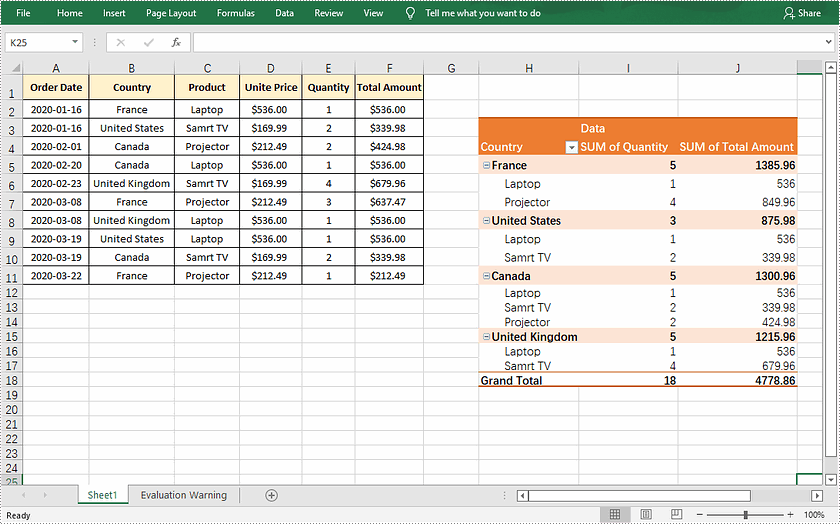
Apply for a Temporary License
If you'd like to remove the evaluation message from the generated documents, or to get rid of the function limitations, please request a 30-day trial license for yourself.
In Microsoft Excel, the blank rows or columns usually indicate the boundaries of data ranges. Therefore, if a blank row or blank column appears in the wrong place will prevent Excel from recognizing the data range correctly when applying some built-in features such as sorting, removing duplicates and subtotals. In such a case, you can delete the blank rows or columns to create a tidy dataset that fit for further processing and analysis. This article will introduce how to programmatically delete blank rows and columns in an Excel document using Spire.XLS for Java.
Install Spire.XLS for Java
First of all, you're required to add the Spire.Xls.jar file as a dependency in your Java program. The JAR file can be downloaded from this link. If you use Maven, you can easily import the JAR file in your application by adding the following code to your project's pom.xml file.
<repositories>
<repository>
<id>com.e-iceblue</id>
<name>e-iceblue</name>
<url>https://repo.e-iceblue.com/nexus/content/groups/public/</url>
</repository>
</repositories>
<dependencies>
<dependency>
<groupId>e-iceblue</groupId>
<artifactId>spire.xls</artifactId>
<version>14.4.1</version>
</dependency>
</dependencies>
Delete Blank Rows and Columns in Excel
The detailed steps are as follows.
- Create a Workbook object.
- Load a sample Excel document using Workbook.loadFromFile() method.
- Get a specified worksheet using Workbook.getWorksheets().get() method.
- Loop through all used rows in the specified worksheet and determine whether the row is blank using XlsRange.isBlank() method.
- Delete the blank rows using Worksheet.deleteRow() method.
- Loop through all used columns in the specified worksheet and determine whether the column is blank using XlsRange.isBlank() method.
- Delete the blank columns using Worksheet.deleteColumn() method.
- Save the result to another file using Workbook.saveToFile() method.
- Java
import com.spire.xls.ExcelVersion;
import com.spire.xls.Workbook;
import com.spire.xls.Worksheet;
public class DeleteBlankRowsAndColumns {
public static void main(String[] args) {
//Create a Workbook object.
Workbook wb = new Workbook();
//Load a sample Excel document
wb.loadFromFile("sample.xlsx ");
//Get the first worksheet
Worksheet sheet = wb.getWorksheets().get(0);
//Loop through all used rows
for (int i = sheet.getLastRow(); i >= 1; i--)
{
//Detect if a row is blank
if (sheet.getRows()[i-1].isBlank())
{
//Remove blank rows
sheet.deleteRow(i);
}
}
//Loop through all used columns
for (int j = sheet.getLastColumn(); j >= 1; j--)
{
//Detect if a column is blank
if (sheet.getColumns()[j-1].isBlank())
{
//Remove blank columns
sheet.deleteColumn(j);
}
}
//Save the document
wb.saveToFile("DeleteBlankRowsAndColumns.xlsx", ExcelVersion.Version2016);
}
}

Apply for a Temporary License
If you'd like to remove the evaluation message from the generated documents, or to get rid of the function limitations, please request a 30-day trial license for yourself.
